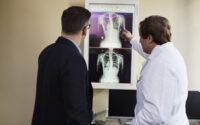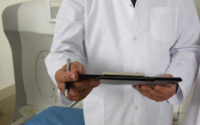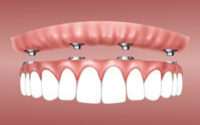Clinical Instructor Questions and Answers
The Clinical Instructor Questions and Answers Papers are published here to help the Exam applicants. A large number of aspirants are searching on the Internet for the Clinical Instructor Model Papers. It is the right place for those Clinical Instructor Questions and Answers Papers.
Since, we are providing the valuable information about the Clinical Instructor Exam. The model papers seekers can stop your process of searching for the Clinical Instructor. Because we have given all the Sample Papers for the Clinical Instructor.
Just in simple steps, you will download the Clinical Instructor Questions and Answers Papers freely. Are you searching for the Clinical Instructor Sample Papers for starting exam preparation? We attached the free downloading links of Clinical Instructor Questions and Answers Papers.
Model Question and Answers on Clinical Instructor Exam
1. The ongoing or systematic assessment of student’s achievement during the curricular programme is known as
(A) Summative evaluation
(B) Formative evaluation
(C) Intermittent evaluation
(D) Concurrent evaluation
2. A 2-month old infant was brought to the health centre for immunization, the infant’s temperature registered at 38-PC. Which is the best course of action that you will take?
(A) Goon with the infant’s immunization
(B) Give paracetamol and wait for his fever lo subside.
(C) Refer the infant to the physician for further assessment
(D) Advice the infant’s mother lo bring him back for immunization when he is well.
3. The muscle layer of the heart is called the
(A) Myocardium
(B) Endocardium
(C) Pcricardium
(D) Parietal pcricardium
4. Absent of speech and activities termed as
(A) Autism
(B) Mutism
(C) Aphasia
(D) Cretinism
5. A common data collecting instrument in nursing research is
(A) Interview
(B) Questionnaire
(C) Rating Scale
(D) Observation Checklist
6. The movement of water through a selective permeable membrane is called
(A) Facilated diffusion
(B) Active transport
(C) Simple diffusion
(D) Osmosis
7. The nurse would increase the comfort of the patient with appendicities by
(A) having the patient lie prone.
(B) flexing patients right knee.
(C) sitting the patient upright in a chair.
(D) turning the patient onto his/her left side.
8. Which of the following acts can a one year old child perform?
(A) Sits down from a standing position
(B) Drinks from cup
(C) Speaks one or two words with meaning
(D) Rings bells purposefully
9. For prevention of Hepatitis A. you decided to conduct health education activities. Which of the following is irrelevant?
(A) Use of sterile syringe and needle.
(B) Safe food preparation and food handling by the vendors.
(C) Proper disposal of human excreta and personal hygeine.
(D) Immediate reporting of water pipe leaks and illegal water connection.
10. Nursing care of the patient receiving intravenous infusion includes which of the following?
(A) Changing the IN catheter daily.
(B) Changing the catheter every 8 hourly
(C) Increasing the rate to make up the correct amount which has not been infused at the end of the shift.
(D) Monitoring the flow rate at least every hour
11. Which of the following settings an extremely depressed client can do best?
(A) Opportunities for decision making
(B) Simple daily routine
(C) Varied activities
(D) Multiple stimuli
12. What would be the primary concern in the case of rubella infection during pregnancy?
(A) Maternal ocular damage
(B) Gestational diabetes
(C) Maternal death
(D) Birth defects
13. The first symptoms for open angle Glaucoma may be
(A) a sudden complete loss of vision.
(B) impairment of peripheral vision.
(C) sudden attacks of acute pain.
(D) constant blurted vision.
14. What do you mean by incidence?
(A) Total cases of any disease
(B) Old cases of any disease
(C) New cases of any disease
(D) All of the above
15. Swine flu influenza is caused by the virus
(A) H1N1
(B) H5N1
(C) H2N2
(D) H5N3
16. Which sterilization method is best for destroying endospores?
(A) Autoclave
(B) Oven
(C) Refrizaration
(D) Pasteurization
17. Kangaroo mother care may be continued for a low birth weight baby upto.
(A) Baby has no sign of hypothermia
(B) Baby has regular breathing
(C) Baby gains weight around 2.5 kg
(D) Baby has no signs of infection and taking feeding
18. Which of the followings describe the proper order of the cardinal movements of the labor (mechanism of labor)?
(A) Engagement, internal rotation, descent, flexion.
(B) Engagement, external rotation, descent, extension.
(C) Engagement. extension, internal rotation, flexion.
(D) Engagement, flexion, Internal rotation, extension, external rotation.
19. 3 C Signs (coughing. choking and cynosis) are the clinical features of
(A) Lactose intolerance
(B) Cleft lip
(C) Pyloric stenosis
(D) Tracho-esophagial fistula
20. The advantage of demonstration method is that
(A) it gives more emphasis on knowledge.
(B) it activates several senses.
(C) it is a substitute of lecture method.
(D) it is easier than other method.
21. A trade union can be regarded as
(A) Primary group
(B) Secondary group
(C) Tertiary group
(D) Reference group
22. A nurse accidently gives a patient the medications that were ordered for the patient‘s roommate. What is the nurse first priority?
(A) Complete an occurrence report
(B) Notify the health cure provider.
(C) Inform the head nurse for the error.
(D) Assess the patient for adverse effects.
23. The priority when providing oral hygiene to an unconscious patient is to
(A) prevent aspiration.
(B) prevent mouth odour.
(C) prevent dental caries.
(D) prevent mouth ulceration.
24. Neonatal period extends upto
(A) 21 days of life
(B) 28 days of life
(C) 30 days of life
(D) 35 days of life
25. A vital aspect of nursing practice in relation to legal aspect is
(A) Documentation
(B) Evaluation
(C) Implementation
(D) diagnosis
26. Coronary artery is the branch of the
(A) Ascending aorta
(B) Subclavian artery
(C) Pulmonary artery
(D) Femoral artery
27. A process of enabling the individual to know himself/herself is the
(A) Guidance
(B) Counselling
(C) Testing
(D) Advice
28. What should be the first action for a new born baby?
(A) Suction
(B) initiation of respiration
(C) Apgar Scoring
(D) Physical examination
29. The pathophysiologic problem in cirrhosis of the liver causing esophageal varices is
(A) dilated esophageal various.
(B) portal hypertension.
(C) ascitis and edema.
(D) loss of regeneration.
30. Sample in a research is referred as
(A) representative of population
(B) high risk study subjects
(C) high risk population
(D) population using in a defined area
31. The census is taken at intervals of
(A) Once every 10 year
(B) Once every 20 years
(C) Once every 5 years
(D) Every year
32. While establishing a therapeutic communication with a child with autism the nurse may encounter which of these problems?
(A) Hallucination
(B) Hearing impairment
(C) Clinging to others
(D) Bizarre behaviour
33. The nurse completes a cervical examination on her labouring mother. She determines that her patient’s (mother) cervix is 1 cm in length. How would the nurse describe this length?
(A) 50% effaced
(B) 25% effaced
(C) 100% effaced
(D) 30% effaced
34. Hallucination is a disorder of
(A) Perception
(B) Consciousness
(C) Memory
(D) Thought
35. ORS does not contain
(A) Glucose
(B) Calcium Lactate
(C) Sodium Bicarbonate
(D) Sodium Chloride
36. Kemicterus, which may occur as a complication of jaundice is a pathological condition of
(A) Liver
(B) Brain
(C) Kidney
(D) Heart
37. How should the patient be positioned to best palpate for lumps or tumors during an examination of the right breast?
(A) Supine with both arms overhead with palms upward.
(B) Sitting with hands clasped just above the umbilicus.
(C) Supine with right arm abducted and hand under the head and neck.
(D) Lying on the right side adducting the right arm on the side of the body.
38. An 82 kg patient has a 45% TBSA burn. Using 4 ml/kg/% TBSA burn during the first 24 hours after injury, the nurse would anticipate a fluid replacement of
(A) 3,690 ml
(B) 7,380 ml
(C) 9,225 ml
(D) 14,760 ml
39. Normal average length of a term healthy newborn is
(A) 40 cm
(B) 50cm
(C) 60cm
(D) 65 cm
40. The variables those to be studied during research are known as
(A) Dependent variables
(B) Independent variables
(C) Intermediate variables
(D) Final variable
41. ASHA worked at
(A) PHC level
(B) District level
(C) State level
(D) Village level
42. Route of administration of vitamin K injection in a newborn-
(A) Subcutaneous
(B) Intramuscular
(C) Intradermal
(D) intravenous
43. The term placenta previa describes which of the following conditions?
(A) The placenta separates from the uterine wall.
(B) All or part of the placenta is positioned between the foetus and the cervix.
(C) The foetus is infetior to the placental position.
(D) The placenta develops before the uterine lining is mature.
44. Teaching the patient with rheumatic fever about the disease, the nurse explains that rheumatic fever is
(A) a Streptococcus Viridans infection.
(B) a viral infection of the endocardium and valves.
(C) a sequel of group A streptococci infection
(D) frequently triggered by immune-suppressive therapy
45. Positive Brudzinski and Kemig’s sign an the symptom of .
(A) Meningitis
(B) Encephalitis
(C) Pneumonia
(D) Glomerulottephritis
46. Which patient is at highest risk for tachycardia?
(A) A healthy basketball player during warm up exercise.
(B) A patient admitted with hypothermia.
(C) A patient with n fever of 103°F.
(D) A 90 year old male taking beta-blockers.
47. Among the following diseases. Which is airborne?
(A) Viral conjunctivitis
(B) Acute poliomyelitis
(C) Diphtheria
(D) Measles
48. National Rural Health Mission was launched in the year
(A) April 1922
(B) April 2005
(C) September 2011
(D) April 2001
49. After delivery of the placenta. the nurse notice that it is not l00% intact What is the nurse’s first concern?
(A) Pulmonary congestion
(B) Haemorrphage
(C) Infection
(D) Tissue perfusion
50. In a severely anemic patient, the nurse would expect to find
(A) Dyspnea and tachycardia
(B) cynosis and pulmonary edema.
(C) Cardiornegaly and pulmonaryfibmsis.
(D) ventricular dysrythmias and wheezing
Download More Questions on Paramedical Science
- ECG Technician
- Dental Technician
- Emergency & Trauma Technician
- Medical Counsellor
- Dialysis Technician
- Nutritionist
- Physiotherapist
- Medical Record Technician
- Operation Theatre Technician
- Clinical Psychologist
- Ophthalmic Technician
- Sanitary Inspector
- Radiographer Technician
- Ward Master
- Pharmacist
- Radiotherapy Technologist
- Medical Laboratory Technician
- X-Ray Technician
Frequently Asked Questions
What makes a good clinical instructor?
There are always demands of a good clinical instructor. What do we mean about a good clinical instructor? A good clinical instructor must have both medical knowledge and technical knowledge. He/She must be good in behavior and have a fluent communication skill. Always keep positive attitude and good relation to the students.
What is the role of a clinical instructor?
Chief role of a clinical instructor is to supervise and coordination between students and administration.
Is this clinical instructor questions for written exam?
Yes this is model question papers for clinical instructor examination for SSC, PSC and other paramedical related written exam.
Can this be used as clinical instructor interview questions?
Yes this is a question of technical knowledge. If interviewer asked you any technical question these question will be helpful for you.



